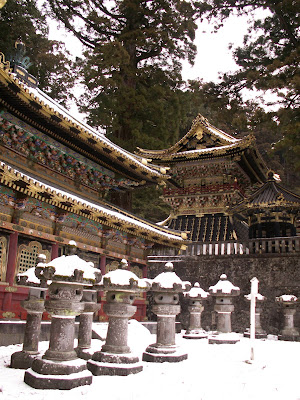
And a perk to making that day trip is that when you're walking to Asakusa Station (Ah-Sock-oo-sa), you get to see the Asahi Brewing Company's corporate office (Notice how the building looks like a beer? Typical Japanese.).


As of May 1, 2006, the city has an estimated population of 93,568.

Shōdō Shōnin established the temple of Rinnō-ji in 782, followed by the temple of Chūzen-ji in 784. The village of Nikkō developed around these temples. The shrine of Nikkō Tōshō-gū was completed in 1617 and became a major draw of visitors to the area during the Edo period. A number of new roads were built during this time to provide easier access to Nikkō from surrounding regions. Nikkō Tōshō-gū, Futarasan Shrine and Rinnō-ji now form a UNESCO World Heritage Site.
So the city itself is famous because it is home to the Toshugu Shrine Complex, the biggest collection of shrines in Japan.




It is also the site where the famous "Hear No, Speak No, See No Evil" monkeys originated. There are monkeys living in the nearby hillsides who will come down to interact with visitors in the Spring and Summer months.

The Japanese can't build a Torii Gate small enough that I can't fit under!
And, if you ever get lost, there are very helpful signs all over the Complex...
The sacred ring toss (I'm sure that's not its actual name). If you get one of 3 rings on the sacred pole (again, can't be the real name) you are supposed to have good luck for the year. I missed, but the girl in our group that made one slipped on the ice 5 minutes later...so I'm not buying it.
During the Meiji period Nikkō developed as a mountain resort, and became particularly popular among foreign visitors to Japan. The Japanese National Railways began service to Nikkō in 1890 with the Nikkō Line, followed by Tobu Railway in 1929 with its Nikkō Line.
After we got back, we rewarded ourselves on our successful journey with dinner at T.Y. Harbor (the foremost microbrewery in Tokyo).
I had the Australian sirloin...quite possibly the best steak I've ever had.
And for dessert, I had a slice of imported David's Cheesecake (from New York). It's supposed to be the world's best, and I agree.










No comments:
Post a Comment